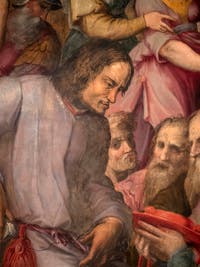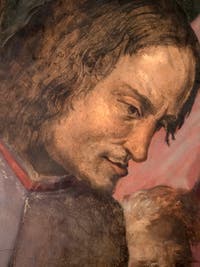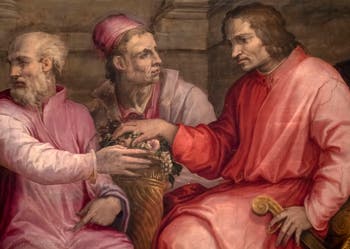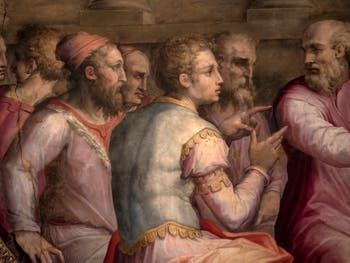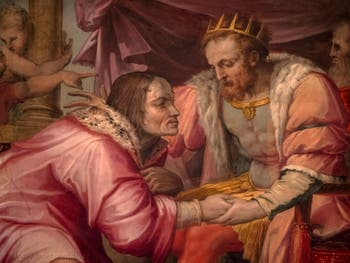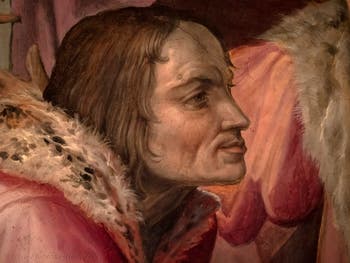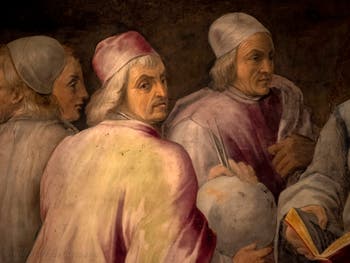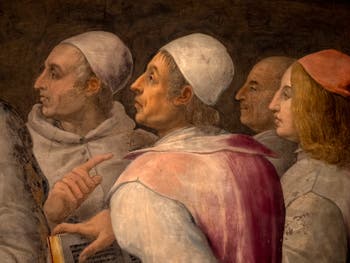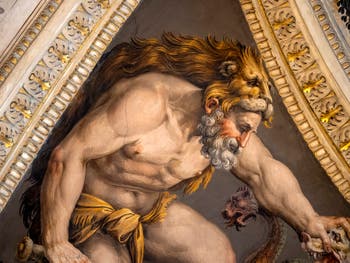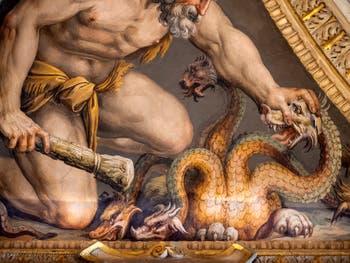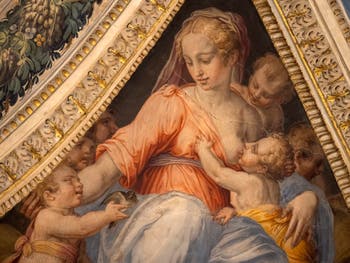Palazzo Vecchio Art Story | Location | Opening Hours Tickets | Authorizations
Art Story Five-Hundred | Tower | Vasari Halls | Dante Mask | Ghirlandaio | Bronzino Sarto Daddi | Salviati | Cortile
Vasari Halls Cosimo Elder | The Magnificent | Penelope Esther Sabines | Pope Leo X
Giorgio Vasari and Marco da Faenza “Lorenzo the Magnificent Room” at Palazzo Vecchio in Florence
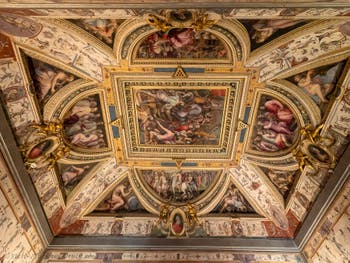
Lorenzo the Magnificent Room The grandson of Cosimo the Elder of Medici, better known as Lorenzo the Magnificent, allowed Florence to regain the splendour of his grandfather's time.
His own father, Piero de Medici named the Gouty, had not been able to continue his father's work with the same brilliance at the economic level but was a humanist, a scholar and a patron in the love of the arts.
Lorenzo the Magnificent was able to assume the heredity of Cosimo the Elder and his father and give Florence international and cultural fame.
Under the government of Lorenzo the Magnificent, many great Florentine artists began their careers, such as Michelangelo or Botticelli.
Lorenzo de Medici frequented the greatest intellectuals of his time, including his friend Pic de la Mirandola and put all his influence at the service of many intellectual and artistic circles.
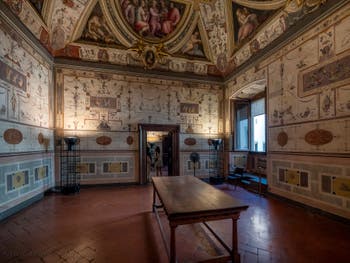
Lorenzo the Magnificent Room But his role was not limited to this; Florence's influence over Italy was also increased.
On one of the frescoes of this room, you can see below Lorenzo the Magnificent receiving gifts from foreign ambassadors, including a giraffe offered by the ambassador of Egypt!
The decoration of this room was made between 1556 and 1558 by Giorgio Vasari and Marco Marchetti da Faenza for frescoes, and Leonardo Ricciarelli with Giovanni di Tommaso Boscoli for stucco.
Giorgio Vasari commented on the decoration of the room of Lorenzo the Magnificent:
“To Lorenzo the Magnificent, patron of arts and letters and a supporter of a policy of balance between the various Italian powers to avoid foreign interference, I dedicate this room adjacent to that of Cosimo the Elder.”
Giorgio Vasari
Giorgio Vasari “Lorenzo the Magnificent receives the tribute of ambassadors” Palazzo Vecchio in Florence
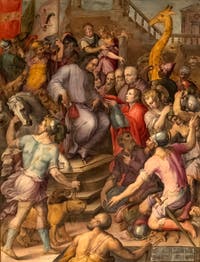
The Magnificent This fresco occupies the centre of the ceiling of the room.
We see Lorenzo the Magnificent sitting in the centre and surrounded by ambassadors of the various Italian powers.
The Papal Chamberlain of Pope Innocent VIII, dressed in red, is on his knees in front of the Magnificient and gives him a cardinal's hat for Lorenzo's son, Giovanni de Medici.
On the left and below, we see an envoy from Aragon offering Berber horses and two lions.
Still down, but on the right, an envoy of the Duke of Milan Ludovico Sforza offers weapons to the Magnificent.
The ambassadors represented are those of Siena, Hungary, Aragon, Bologna, Perugia and Faenza.
In the upper right, we see envoys of the Sultan of Cairo, Caiebo, who offer a giraffe and jewels.
Finally, just above Lorenzo the Magnificent, Vasari represented the virtues of prudence and magnanimity.
Giorgio Vasari “Lorenzo of Medici at the Diet of Cremona” Palazzo Vecchio in Florence
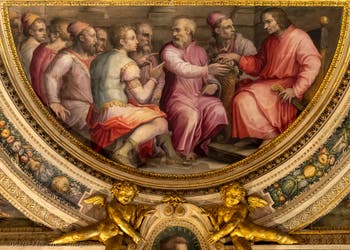
Lorenzo Diet of Cremona This fresco refers to the move of Lorenzo the Magnificent to Cremona in February 1483 to seal an agreement with his allies Ferdinand of Aragon and Ludovico Sforza against the Venetians and the Pope.
The central character dressed in burgundy colour is the cardinal of Mantua, legate of the pope, and the one between him and Lorenzo de Medici with a red hat is the Duke of Ferrara, Ercole d'Este.
The young blond man in the foreground who partly turns his back on us and whose two hands are seen is the Duke of Milan, Ludovico Sforza.
Lorenzo the Magnificent sits to the right, one hand resting on a horn of abundance while the other holds a sword.
Giorgio Vasari “Lorenzo the Magnificent goes to Naples to see King Ferdinand of Aragon” Palazzo Vecchio in Florence
On both sides of this fresco are painted the allegories of Piety and Faith.Vasari thus insists on the decision taken by Lorenzo the Magnificent to go to Naples, at the risk of his life, to meet his enemy King Ferdinand of Aragon.
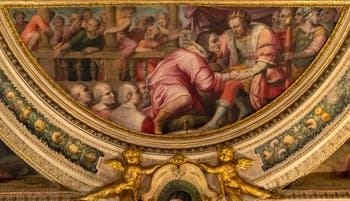
Lorenzo King Ferdinand Lorenzo the Magnificent had dared to throw himself into the mouth of the wolf to try to reason Ferdinand of Aragon and try to end the war between Naples and the Florentines.
A war supported and initiated by Pope Sixtus IV.
Lorenzo de Medici stayed in Naples from 1479 to 1480 and was received with all honours by the King of Naples and Aragon.
The Magnificent succeeded in his diplomatic poker shot and Ferdinand of Aragon accepted Florence's peace offer.
Apart from Lorenzo the Magnificent and the King, who are easily identifiable, the three characters at the bottom and left are from left to right, Paolantonio Soderini, Piero Capponi and Giovanni de Medici.
The skinny and bearded figure whose face is seen behind the King's seat and to the left of the soldier dressed in the antique is Diotisalvi Neroni, the enemy of Lorenzo de Medici.
Giorgio Vasari “The Taking of Sarzana” Palazzo Vecchio in Florence
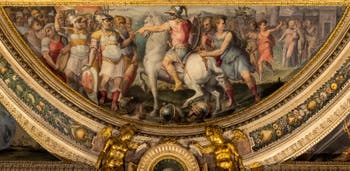
The Taking of Sarzana This fresco recounts one of the episodes of the war between the Genoese and the Florentines in Lunigiana.
The Florentines troops, commanded by Lorenzo the Magnificent had the upper hand over the Genoese.
Lorenzo the Magnificent is depicted in the centre of the fresco, on a white horse and giving orders.
This victory then gave rise to the surrender of the city of Sarzana in 1487.
On the right of the fresco, we see the inhabitants of Sarzana come to meet Lorenzo the Magnificent by carrying an olive branch as a sign of peace and the keys of the city in the act of submission.
Giorgio Vasari “Lorenzo the Magnificent between Philosophers and Literates” Palazzo Vecchio in Florence
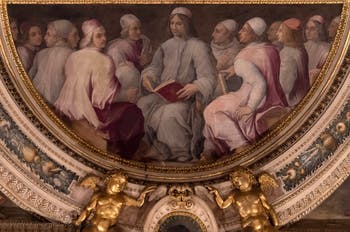
Lorenzo Philosophers and Literates In this fresco, Vasari recalls the qualities of Lorenzo the Magnificent in terms of philosophical and literary scholarship.
He was indeed an excellent poet and recognized as such by his most illustrious contemporaries.
A talent he regretted not being able to use enough because of his daily involvement in the management of Florence's business.
Lorenzo the Magnificent used his power and wealth to develop humanism, letters and philosophy in Florence by surround himself with famous friends and scholars Vasari represented around him.
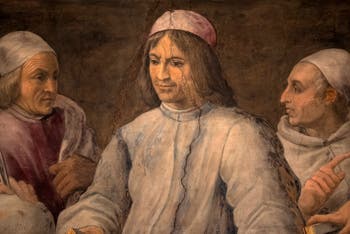
Lorenzo Philosophers and Literates Lorenzo the Magnificent is sitting in the centre.
Right are sitting Gentile of Urbino, bishop of Arezzo, Demetrio Calcondila with the red mantle.
The philosopher and theologian Giovanni Pic de la Mirandola with the red hat is just behind Calcondila with long hair and a pink hat.
Behind Pic de la Mirandola is Angelo Poliziano, who was the friend of Lorenzo de Medici, but also the tutor of his children, Peter and John.
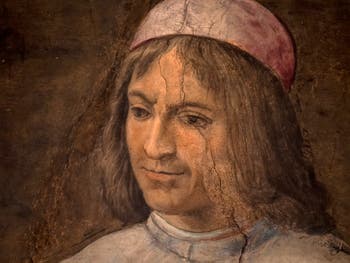
Lorenzo Philosophers and Literates The son of Lorenzo de Medici, John, Giovanni de Medici, will become pope under the name of Leo X.
We can see the poet and philosopher Marsilio Ficino, dressed in red with a clear stole and a white hat on the left part of the fresco.
The humanist Cristoforo Landino is depicted with his back and turning his head towards us, holding a globe and a compass.
The face behind Landino's head is that of the great art theorist, mathematician, painter and architect, Leon Battista Alberti.
Giorgio Vasari “Portrait of Giovanni de Medici, future Pope Leo X” Palazzo Vecchio in Florence
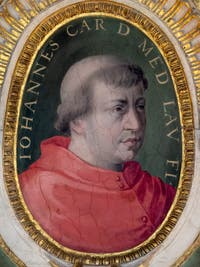
Pope Leo X Giovanni de Medici (1475-1521) was introduced to an ecclesiastical career at a very young age and was appointed cardinal by Pope Innocent VIII when he was only thirteen years old.
However, this appointment included the condition that Giovanni de Medici should not exercise his office as cardinal until sixteen.
After becoming one of the most prominent figures in the Roman Curia, Giovanni de Medici succeeded in being elected pope under the name of Leo X in 1513.
His work as a pope was essentially focused on patronage favouring the arts and letters without limits.
The sumptuous feasts also characterized his papacy years, leaving Vatican finances in a critical state when he died in 1521.
Giorgio Vasari “Giuliano de Medici, brother of Lorenzo the Magnificent” Palazzo Vecchio in Florence
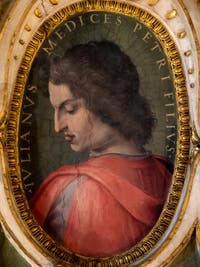
Giuliano de Medici Giuliano de Medici (1453-1478) was the brother of Lorenzo the Magnificent.
He distinguished himself for his taste for arts and letters and had as friends the most influential humanists of Florence, including Angelo Poliziano and Marsilio Ficino.
He had a brutal death, stabbed during Mass in the Basilica of Santa Maria del Fiore on 26 April 1478 in what was called the conspiracy of Pazzi, which, at the instigation of Pope Sixtus IV, had tried to seize Florence by assassinating Giuliano and Lorenzo.
Lorenzo managed to escape his assassins by taking refuge in the sacristy of the basilica and put an end to the conspiracy but never succeeded in overcoming the grief associated with the loss of his brother.
Lorenzo the Magnificent and his brother Giuliano are buried side by side, in the same coffin, in the new sacristy created by Michelangelo in the Medici Chapel.
Giorgio Vasari “Giuliano de Medici, son of Lorenzo the Magnificent” Palazzo Vecchio in Florence
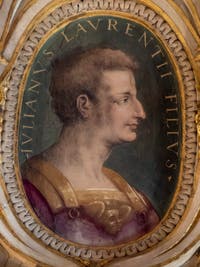
Giuliano de Medici The son of Lorenzo the Magnificent, Giuliano de Medici (1479-1516) bears the name of his uncle murdered one year before his birth.
Like the other members of the Medici family, he was forced into exile in 1494 and could not return to Florence until 1512.
He then regained power in Florence and ruled the city in moderation until late 1513.
He then went to Rome and married Filiberta of Savoy in 1515 in Turin, obtaining the title of Duke of Nemours and captain-general of the Church.
His funerary monument, carved by Michelangelo at the request of Pope Leo X, is also located in the Sagrestia Nuova of the Medici Chapel, next to the tomb of his father and uncle.
Giorgio Vasari “Peter II of Medici, son of Lorenzo the Magnificent” Palazzo Vecchio in Florence
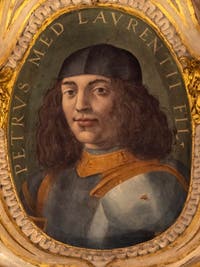
Peter II of Medici The youngest of the sons of Lorenzo the Magnificent, Piero de Medici (1472-1503) succeeded his father Lorenzo when he died on 8 April 1492.
He turned out to be totally incapable of governing Florence.
He suffered the criticism and attacks of Jerome Savonarola, who had no idea but to drive the Medici out of power.
This succeeded with the entry into Florence of the French troops of King Charles VIII, with whom Savonarola did not hesitate to associate himself by referring to one of his visions in which Florence was liberated from the Medici by the said King Charles VIII.
Peter II de Medici first fled to Venice, and subsequently, the members of the Medici family were not only condemned to exile in 1494 but also deprived of their possessions with the ransacking of the Medici Riccardi Palace and the destruction and theft of many works of art from the collection of Lorenzo the Magnificent.
Subsequently, the Republic of Florence was restored in the form of a theocracy led by Jerome Savonarola and all the excesses that ensued.
Peter II of Medici made several military attempts to take over Florence, but they all failed.
He allied himself with the new King of France, Louis XII, but that did not bring him luck either as he died drowned in the Garigliano River trying to flee during a battle between French and Spanish.
Vasari Halls Cosimo Elder | The Magnificent | Penelope Esther Sabines | Pope Leo X
Art Story Five-Hundred | Tower | Vasari Halls | Dante Mask | Ghirlandaio | Bronzino Sarto Daddi | Salviati | Cortile
Palazzo Vecchio Art Story | Location | Opening Hours Tickets | Authorizations
Back to Top of Page


